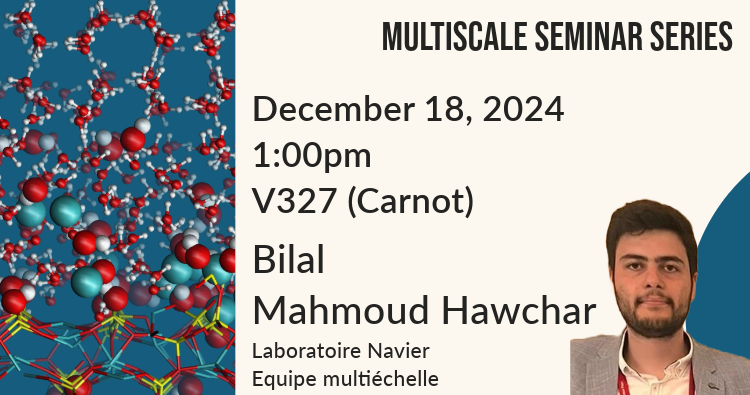
Séminaire Multiéchelle : Bilal Mahmoud Hawchar (Navier – Multiéchelle)
The study of crystallization pressure by molecular simulation and microfluidic experiments
Abstract:
The process of salt crystallization within porous media is widely recognized as a substantial contributor to the deterioration of construction materials, geomaterials, and built heritage. When salts crystallize, they can exert mechanical pressure on pore surfaces, leading to material damage. However, the crystallization within porous networks remains poorly understood despite its importance. We propose an investigation combining molecular simulations, theoretical development, and microfluidic experiments to quantify and clarify the origin of the crystallization pressure at the finest scale. This study should allow the identification of the parameters controlling the phenomenon and thus pave the way to mitigate or prevent salt damage.
At thermodynamic equilibrium, crystallization pressure results from the change in the solubility of a crystal as it is compressed. Direct molecular dynamics simulations to compute the solubility of salts are challenging because the time scale of dissolution and precipitation, microseconds or more, is at the limit or beyond computing capabilities. For this reason, we use a thermodynamic integration approach to overcome this issue. With this approach, we can quantify the effect of stress on NaCl solubility and, more specifically, the effect of stress anisotropy, which has been disregarded so far. We use these results to revisit the existing theory describing crystallization pressure and extend it to account for stress anisotropy. Moreover, we conduct molecular simulations to determine the critical pressure threshold at which the wetting film, separating the crystal from the pore’s surface and responsible for the crystal growth, will disappear. This approach offers valuable insights into the stability of this film under varying pressure and temperature conditions.
Furthermore, we establish a protocol to control the precipitation and growth of salt crystals in microfluidic models. This protocol employs a fluorescent dye technique combined with image analysis to detect damage, measure channel deformation, and, consequently, determine the crystallization pressure.
Short bio:
Bilal Mahmoud Hawchar is a PhD candidate at the Navier Laboratory, in collaboration with the Laboratory of Mechanics Paris-Saclay (LMPS) and the Earth Science Institute of Orléans (ISTO). He holds a master’s degree in civil engineering from École Normale Supérieure Paris-Saclay. His research focuses on understanding the properties and behavior of materials at the finest scale. He combines molecular simulations, theoretical models, and experimental techniques to study phenomena like crystallization pressure and other material transformations under different conditions.

